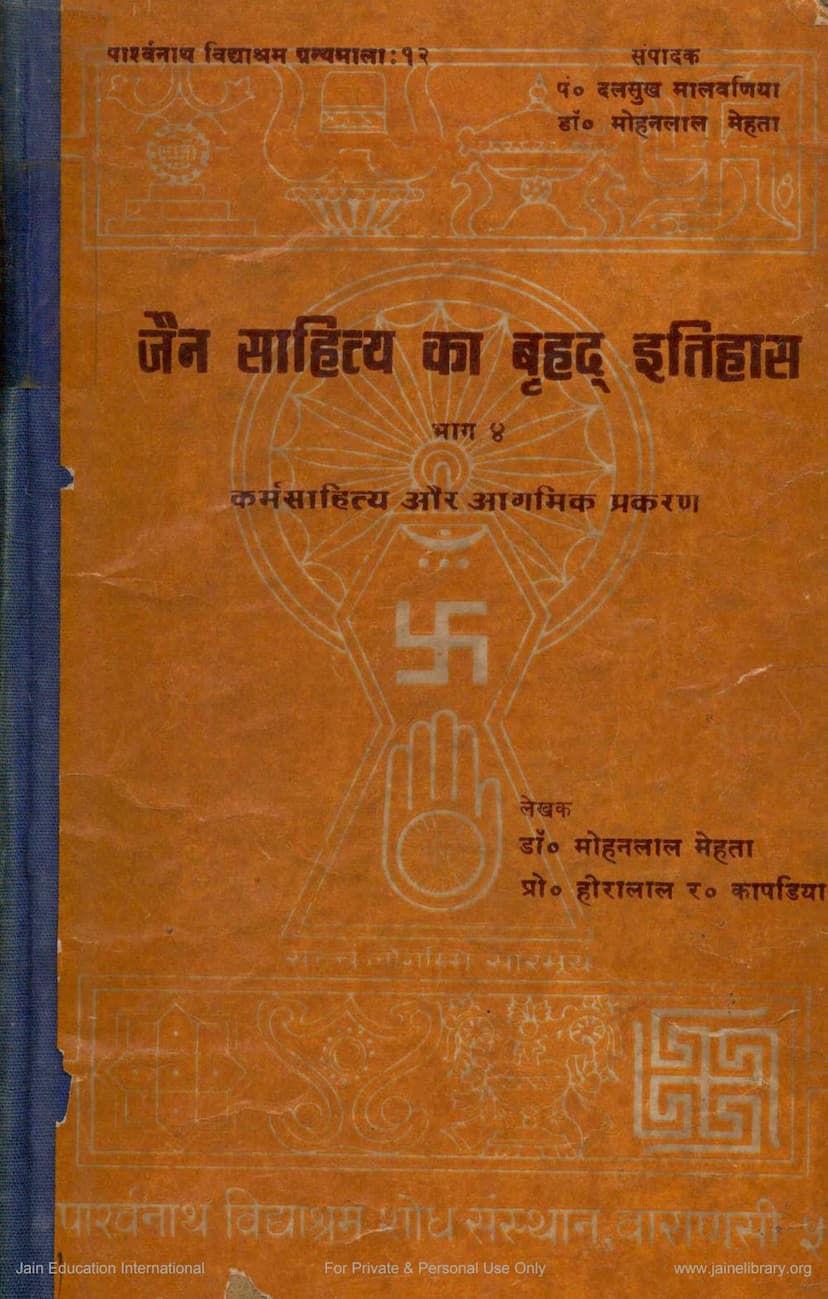Jain Sahitya Ka Bruhad Itihas Part 4
Added to library: September 2, 2025

Summary
This document is the fourth volume of the comprehensive history of Jain literature, titled "Jain Sahitya Ka Bruhad Itihas Part 4". Authored by Mohanlal Mehta and Hiralal R. Kapadia, and published by Parshwanath Shodhpith Varanasi, it focuses on "Karma Literature and Agamic Chapters". The book was first published in 1968 and a second edition was released in 1991.
Key sections and themes covered in the book include:
-
Karma Theory (Karma-vada): This section delves into the fundamental principles of Jain karma theory. It explains the meaning of karma, the causes and processes of karma bondage, the rise and cessation of karma, the nature of karma fruits, the duration of karma, the intensity of karma fruits, the particles of karma, and the various states of karma. It also discusses the relationship between karma and reincarnation, emphasizing that every action has a consequence, and if not experienced in the present life, requires future lives. It clarifies that karma is not fatalism (Niyativada) but allows for limited free will (Ichha-swatantrya). The text also contrasts karma theory with opposing viewpoints like time-based causality (Kalavada), inherent nature (Swabhavavada), destiny (Niyativada), chance (Yadrichhavada), material elements (Bhutavada), and the creator-based theory (Purushavada).
-
Karma Literature: This part provides a detailed overview of Jain literature related to karma.
- Karma Praabhrit (Karmapraabhrit): It discusses the origins of this text within the Jain scriptural tradition, its authors (Pushpadanta and Bhutabali), and its subject matter, which is divided into six sections: Jivasthan, Kshudrakbandha, Bandhaswaamitvavichaya, Vedana, Vargana, and Mahabandha. The intricate details of Jivasthan are elaborated, including various classifications of beings based on senses, body, mind, speech, feeling, passions, knowledge, restraint, faith, predisposition, and diet.
- Commentaries on Karma Praabhrit: The text lists and briefly describes significant commentaries on Karma Praabhrit, including those by Kundakunda (Parikarma), Shamkund (Paddhati), Tumbulur (Chudamani and Panjika), Samantabhadra (Tika), Bappadeva (Vyakhya Prajnapti), and Virasena (Dhavala). The Dhavala commentary by Virasena is highlighted as a major work.
- Other Karma Literature: This section covers a broader range of Jain karma literature, categorizing it into Digambara and Shvetambara traditions. It mentions influential texts like Karma Prakriti, Panch Sangraha, Shat Karma Granth, and others, along with their commentaries and authors. Key Digambara works discussed include Gommatasara and Labdhisara by Nemichandra. Shvetambara works like Karma Prakriti by Shivasharma Suri and Panch Sangraha by Chandrashimhsttar are also covered.
-
Agamic Chapters: This section explores chapters related to Jain scriptures and their interpretations.
- Origin and Development of Agamic Chapters: It discusses how these chapters evolved from the original Jain canons.
- Agamsara and Dravyanuyoga: It focuses on texts that summarize or elaborate on the Agamas, particularly those dealing with Dravyanuyoga (the branch of Jainism that deals with substances and their properties).
- Works of Acharya Kundakunda: This prominently features the works of Acharya Kundakunda, considered a highly influential figure in Jainism. His key texts mentioned are Pravachanasara, Samayasara, Niyamasara, Panchastikayasara, and the eight Pahudas. The summary provides insights into the philosophical and practical aspects covered in these seminal works.
- Other Agamic Chapters: The text lists numerous other important agamic works, including Jivasamas, Jivavichara, Pannavanai, and various Sangrahani texts, which systematically explain Jain principles and doctrines.
-
Dharmopadesha (Religious Teachings): This substantial section provides an extensive catalog of Jain texts that offer religious guidance and teachings. It covers a wide array of works from various authors and traditions, often categorizing them by their focus (e.g., on ethical conduct, virtues, spiritual practices). It mentions texts like Upadeshamala, Upadesha Pad, Upadesha Prakaran, Dharmopadeshamala, Upadesha Rasayana, Upadesha Kandali, Hitoopadeshamala, Upadesha Chintamani, Prabodha Chintamani, Upadesha Ratnakara, Upadesha Saptatika, Upadesha Tarangini, Atmanushasana, Dharmasara, Dharmabindu, Dharmaratnakaranda, Dhammavithi, Dharmamrita, Dharmopadesha Prakaran, Dharmasarvadhikar, Bhavabhavana, Bhavanasara, Bhavanasandhi, Brihann mithyatvamathana, Darshana Saptati, Darshana Shuddhi, Samyakvaprakaraṇ, Samyaktya Kaumudi, Sadrishtya, Dana Shila Tapa Bhavana Kulak, Danopadeshamala, Dana Pradipa, Shiloopadeshamala, Dharmakalpadruma, Vivekamnjari, Viveka Vilas, Vardhamana Deshana, Sambodha Prakaraṇ, and Tattaprakasaga.
-
Yoga and Spirituality: This section explores Jain perspectives on yoga and spiritual practices.
- Jain Interpretation of Yoga Philosophy: It discusses how Jainism interprets yogic philosophy, referencing Patanjali's Yoga Sutras from a Jain viewpoint.
- Six Angas of Yoga: The text outlines the eight limbs of yoga as described in Jain tradition, including Yamas, Niyamas, Asanas, Pranayama, Pratyahara, Dharana, Dhyana, and Samadhi.
- Works on Yoga and Spirituality: It lists various Jain texts dedicated to yoga and spiritual development, such as Yogadarshana, Yogacharyas' works, Yogabindu, Yogashataka, Yogadrishti Samuchchaya, Brahm Siddhanta Samuchchaya, Yogavihana Vishika, Paramaprakasha, Yogasara, Yogashastra, Jnanaṁrṇava, Dhyana Deepika, and many others focusing on meditation and spiritual absorption. The summary provides a glimpse into the vastness of Jain literature on these profound subjects.
The book serves as a foundational reference for understanding the breadth and depth of Jain literature, particularly its philosophical and practical aspects concerning karma and spiritual practices. The detailed index at the end further aids in navigating this extensive body of knowledge.